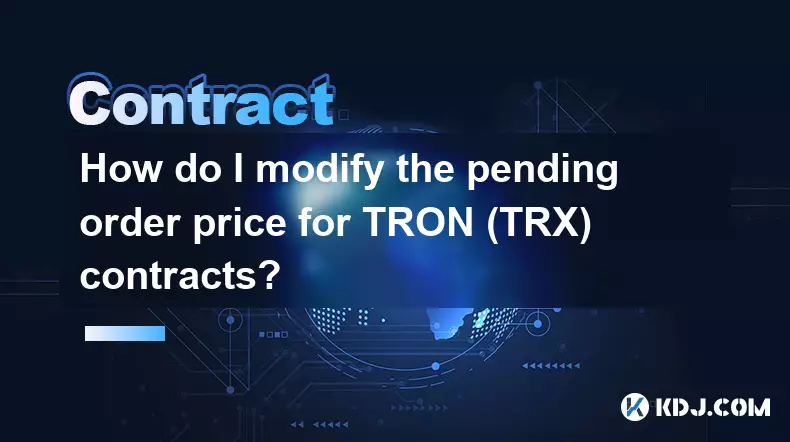-
 bitcoin
bitcoin $109667.069529 USD
-3.03% -
 ethereum
ethereum $3936.685804 USD
-4.07% -
 tether
tether $1.000493 USD
0.01% -
 xrp
xrp $2.771823 USD
-4.74% -
 bnb
bnb $957.805027 USD
-5.34% -
 solana
solana $196.735100 USD
-6.68% -
 usd-coin
usd-coin $0.999727 USD
-0.01% -
 dogecoin
dogecoin $0.227355 USD
-5.12% -
 tron
tron $0.335205 USD
-0.81% -
 cardano
cardano $0.779256 USD
-3.59% -
 ethena-usde
ethena-usde $0.999900 USD
-0.06% -
 hyperliquid
hyperliquid $42.492095 USD
-6.61% -
 chainlink
chainlink $20.501853 USD
-4.34% -
 avalanche
avalanche $28.952606 USD
-11.21% -
 stellar
stellar $0.356038 USD
-3.93%
How do I modify the pending order price for TRON (TRX) contracts?
You can modify a pending TRX order’s price only if the platform supports it; otherwise, cancel and resubmit. Always confirm wallet authorization and network fees.
Sep 26, 2025 at 05:18 am

Understanding TRON (TRX) Contract Mechanics
1. TRON contracts operate on the TRON blockchain, leveraging its high throughput and low transaction fees to facilitate decentralized trading and financial operations. These contracts are immutable once deployed, meaning their core logic cannot be altered after creation. However, certain parameters within them, such as pending order pricing, may be adjustable depending on the design of the smart contract.
2. Pending orders in TRX-based derivatives or futures platforms typically represent conditional trades set to execute when specific price thresholds are met. These orders are managed by off-chain matching engines or on-chain logic governed by the contract’s rules. The ability to modify a pending order's price depends heavily on whether the system allows user-initiated updates before execution.
3. Most decentralized exchanges or derivatives platforms built on TRON use layered architectures where the front-end interface communicates with both the blockchain and centralized relayers. This hybrid model enables features like order cancellation or adjustment, even though the underlying blockchain does not natively support mutable transactions.
4. Users must verify if the platform hosting the TRX contract supports order modification. Some platforms only allow cancellation and re-submission of orders instead of direct price edits. This limitation exists to maintain consistency in the order book and prevent manipulation.
5. Interaction with these systems usually requires a compatible wallet such as TronLink or BitKeep, which signs transactions authorizing changes to pending orders. Without proper authorization and network confirmation, no modifications take effect on the blockchain level.
Steps to Adjust Pending Order Prices
1. Access your account on the TRON-based trading platform where the pending order was placed. Ensure you are logged in with the same wallet address used to create the original order. Authentication is critical because order ownership determines modification rights.
2. Navigate to the “Open Orders” or “Pending Positions” section within the platform’s interface. Locate the specific TRX contract order you wish to adjust. Each entry should display details including entry price, trigger conditions, leverage, and expiration time.
3. Click the edit or modify button associated with the selected order. Not all platforms provide this option; some replace it with a “Cancel & Replace” function. If editing is supported, a pop-up window will appear allowing input of a new trigger or limit price.
4. Enter the updated price value based on current market data and your strategy. Confirm that the revised price aligns with the contract’s allowable range—some systems enforce minimum/maximum deviation limits from the last traded price to prevent erroneous inputs.
5. Submit the change request. Your wallet will prompt for signature approval. After signing, the network processes the update as a new transaction. Monitor the status until confirmation appears on-chain, indicating successful modification.
Risks and Limitations in Modifying Orders
1. Market volatility can cause slippage between the time you initiate a price change and when it gets confirmed on the TRON network. During rapid price movements, especially during major news events or macroeconomic shifts, the updated order might execute at an unintended level.
2. Gas costs, although minimal on TRON compared to other blockchains, still apply when modifying orders through on-chain transactions. Frequent adjustments could accumulate expenses over time, particularly for traders using tight stop-loss or take-profit strategies.
3. Some TRX contracts are designed with fixed parameters to ensure fairness and transparency. In such cases, altering a pending order after submission is impossible without canceling it first. Attempting unauthorized changes results in transaction rejection by the network.
4. Third-party platforms may impose rate limits or session timeouts that interfere with real-time order management. A delayed response due to connectivity issues might result in missed opportunities or failed modifications.
5. Smart contract bugs or exploits, while rare, can affect order handling. Always review audit reports of the platform and avoid interacting with unaudited or obscure TRON-based protocols offering contract trading.
Frequently Asked Questions
Can I change the price of a pending TRX futures order after placing it?Yes, but only if the platform supports order modification. Many do not allow direct edits and require cancellation followed by a new order submission.
What happens if my price modification fails on the TRON network?A failed modification usually stems from insufficient bandwidth, expired transactions, or incorrect parameters. Check your wallet balance, network congestion, and input values before retrying.
Do all TRON-based DEXs allow pending order adjustments?No. Decentralized exchanges vary in functionality. Some offer full edit capabilities while others restrict changes to maintain system integrity and prevent front-running.
Is there a fee for updating a TRX contract order price?While TRON has negligible transaction fees, some platforms charge service fees for order modifications. These fees help deter spam and excessive order book alterations.
Disclaimer:info@kdj.com
The information provided is not trading advice. kdj.com does not assume any responsibility for any investments made based on the information provided in this article. Cryptocurrencies are highly volatile and it is highly recommended that you invest with caution after thorough research!
If you believe that the content used on this website infringes your copyright, please contact us immediately (info@kdj.com) and we will delete it promptly.
- BlockDAG's Miner Rollout: A Global Expansion Story
- 2025-09-26 14:45:12
- XPL Surge: Is It a Dead Cat Bounce or the Real Deal?
- 2025-09-26 14:45:12
- XRP, Axelar, and Interchain Transfers: A New Era for DeFi?
- 2025-09-26 14:25:13
- Epstein Files, Antonio Brown, and Trump: A Wild Intersection
- 2025-09-26 14:25:13
- Tech-Savvy Parents Face Unexpected Challenges: A Guide to Childproofing the Digital Age
- 2025-09-26 14:30:01
- Riding the XRP Wave: Debt Tokenization and the Next Bull Cycle
- 2025-09-26 14:30:01
Related knowledge

How do I enable the "scalping-only" mode for Cardano (ADA) contracts?
Sep 24,2025 at 03:19am
Understanding Scalping Strategies in Crypto Derivatives1. Scalping in cryptocurrency trading refers to executing multiple short-term trades within min...

What is the maximum position limit for Cardano (ADA) contracts?
Sep 23,2025 at 11:00pm
Understanding ADA Futures and Derivatives Market Structure1. Cardano (ADA) futures contracts are offered by several major cryptocurrency derivatives e...

What is the maker fee for Cardano (ADA) contracts?
Sep 26,2025 at 09:01am
Understanding Maker Fees in Cardano (ADA) Contracts1. The concept of maker fees applies broadly across decentralized exchanges and smart contract plat...

How can I view open interest in Cardano (ADA) contracts?
Sep 24,2025 at 07:36am
Understanding Open Interest in Cardano Derivatives1. Open interest refers to the total number of outstanding derivative contracts, such as futures or ...

What is the function of the insurance fund in Cardano (ADA) contracts?
Sep 24,2025 at 02:18am
Understanding the Role of Insurance Funds in Cardano Smart Contracts1. The insurance fund within Cardano's ecosystem is not a native feature directly ...

How can I view historical transaction records for Cardano (ADA) contracts?
Sep 24,2025 at 04:01pm
Understanding Cardano's On-Chain Data Structure1. Cardano operates on a proof-of-stake blockchain that records all transactions in blocks secured thro...

How do I enable the "scalping-only" mode for Cardano (ADA) contracts?
Sep 24,2025 at 03:19am
Understanding Scalping Strategies in Crypto Derivatives1. Scalping in cryptocurrency trading refers to executing multiple short-term trades within min...

What is the maximum position limit for Cardano (ADA) contracts?
Sep 23,2025 at 11:00pm
Understanding ADA Futures and Derivatives Market Structure1. Cardano (ADA) futures contracts are offered by several major cryptocurrency derivatives e...

What is the maker fee for Cardano (ADA) contracts?
Sep 26,2025 at 09:01am
Understanding Maker Fees in Cardano (ADA) Contracts1. The concept of maker fees applies broadly across decentralized exchanges and smart contract plat...

How can I view open interest in Cardano (ADA) contracts?
Sep 24,2025 at 07:36am
Understanding Open Interest in Cardano Derivatives1. Open interest refers to the total number of outstanding derivative contracts, such as futures or ...

What is the function of the insurance fund in Cardano (ADA) contracts?
Sep 24,2025 at 02:18am
Understanding the Role of Insurance Funds in Cardano Smart Contracts1. The insurance fund within Cardano's ecosystem is not a native feature directly ...

How can I view historical transaction records for Cardano (ADA) contracts?
Sep 24,2025 at 04:01pm
Understanding Cardano's On-Chain Data Structure1. Cardano operates on a proof-of-stake blockchain that records all transactions in blocks secured thro...
See all articles










































































